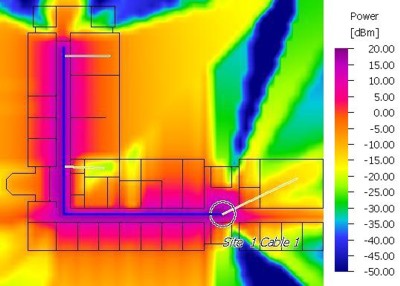Leaky Feeder Cable Models
ProMan offers three different prediction models for leaky feeder cables.
As a radiating cable has gaps or slots in its outer sheath to allow signal to leak into or out of the cable along its entire length, special prediction models have to be used to predict the wave propagation. The transmission power along the cable decreases from the feeding point according to the losses defined on the Cell Definition tab.
Shortest Distance Model (SDM)
The shortest distance model predicts the received power by always using the shortest geometric distance between radiating cable and receiving point. The obstacles of the environment (walls) between this cable point and the receiving point are taken into account in terms of different transmission losses depending on the specified materials of the objects. Optionally, the angle of incidence can be considered for the determination of the transmission loss as well.
The following figure shows a sample prediction of the power received from a radiating cable (blue line) along a building corridor. The three exemplary drawn rays depict the propagation paths, which have been considered for the selected receiving points.

Smallest Transmission Loss Model (STL)
Compared to the SDM, the smallest transmission loss model uses a discretization of
the leaky feeder cable, discrete transmitting positions
along the cable.
Starting from these discrete transmitting locations, the direct propagation path
covering the smallest overall transmission loss between radiating cable and
receiving point is taken into account. The discretization of the cable as well as
the other parameters of the model can be specified in the Parameter for
Prediction of Radiating Cables dialog shown below.
The following figure shows a sample prediction of the power received from a radiating cable (blue line) along a building corridor. The four exemplary drawn rays depict the propagation paths, which have been considered for the selected receiving points.

Smallest Path Loss Model (SPL)
The smallest path loss model works in almost the same way as the smallest transmission loss model, it uses a discretization of the leaky feeder cable. Starting from these discrete transmitting locations, the direct propagation path covering the smallest overall path loss between radiating cable and receiving point is taken into account. The discretization of the cable as well as the other parameters of the model can be specified in the settings dialog shown below.
The following figure shows a sample prediction of the power received from a radiating cable (blue line) along a building corridor. The four exemplary drawn rays depict the propagation paths, which have been considered for the selected receiving points.

Parameters and Settings of the Models
